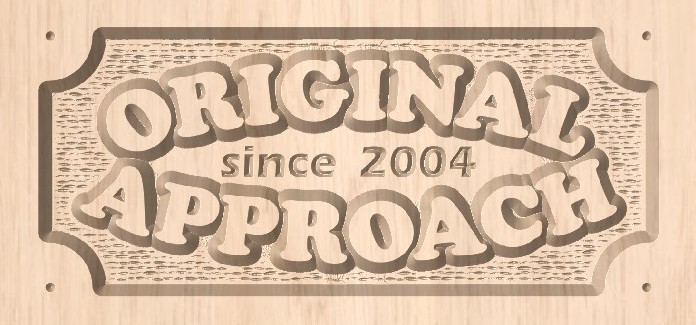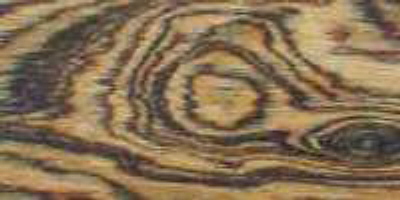|
BOTANICAL NAME: Cordia alliodora, Cordia elaeagnoides, and cordia gerascanthus
of the family Boraginaceae. Mostly reported as alliodora, so presumably that is
the most common subspecies.
COMMON NAMES: amapa asta (Mexico), anacahuite, barcino, baria (Cuba), bois de
rose, canalete (Colombia, Venezuela), cordia, cype, freijo, laurel, loro negro
(Argentina), louro pardo (Brazil), Mexican rosewood, peterebi, salmwood,
siricote, solera.
The "bois de rose" I'm not so sure about since I think there is a specific
rosewood of that name that is very different from bocote.
TYPE: hardwood or softwood? odd, but no one says.
COLOR: reports on color are all over the map, but the one that fits my
experience is "ranges from tan to golden brown to pale golden yellow, with
irregular dark brown streaks". Other reports say the streaks can be red, or
green, or some say black, and that the heartwood is variously "tobacco" colored,
dark brown, nearly white, red, and red brown, take your pick. With aging (as you
can see in the pictures) I do agree that the heartwood can be tobacco colored or
dark brown and the streaks appear almost black. The heartwood is reportedly
rather sharply demarcated from the grayish or yellowish sapwood.
GRAIN: varies from straight to roey. On this there seems to be universal
agreement. Some also say shallowly interlocked grain. Generally contains
wonderfuly curvy lines and swirls. See the pics.
TEXTURE: variously reported as coarse to medium to fine, with a somewhat oily or
waxy appearance and feel. I have not experienced "fine" texture; I'd say medium
and I agree with the "oily or waxy" but it's not strongly either one. I've also
seen comments that it is similar to teak, and I agree although I don't think it
dulls tools quite as much as teak.
PROPERTIES/WORKABILITY: machines and glues well, although there are occasional
reports that it is somewhat difficult to glue. In my experience, there is no
problem gluing it. It is easy to work, responds well to both hand and machine
tools, and takes nails and screws well, although I've seen reports that nailing
may split it. It dulls tools slightly and with dull tools you can raise a bit of
a fuzz, but generally its turnability is easy to moderate.
DURABILITY: variously rated as moderately durable and highly durable and very
resistant to marring and denting. My experience is on the high side. It is
reported to be highly resistant to insects and decay. Reportedly resistant to
preservative treatment and with permeable sapwood.
HARDNESS / STRENGTH: generally reported to be (and my experience supports this)
a hard, heavy, strong and dense wood. Compression strength reportedly comparable
to mahogany. "Possesses medium strength properties in all categories."
FINISH: will take a moderately high natural gloss and takes stains and finishes
well, but anyone who stains it should be shot. Finishes well with wax.
Polyurethane finish also good since that highlights the yellow background. The
yellow deepens with any finish, but not adversely so.
STABILITY: medium movement
BENDING: good steam bending classification, similar to teak
ODOR: variously reported as "mildly fragrant" and "distinctive dill-like aroma"
when fresh
TASTE: nothing distinctive reported
SOURCES: Central America and the West Indies, including Mexico, Belize,
Guatemala, Honduras, Nicaragua, Colombia, Cuba, Dominican Republic, Haiti and
Jamaica. Mostly, it is from Mexico. One report cited Northern Florida.
USES: cabinetmaking, decorative veneer, fine furniture, boat decking, decorative
and figured veneer, turnery, inlay work, interior trim, balusters, excelsior,
floor lamps, moldings, parquet flooring, and wainscoting. Very popular for knife
handles and pens because of the extreme figure available. Reportedly sometimes
used as a substitute for mahogany, teak or walnut, but I find that hard to
believe because those woods are very mild in appearance compared to most bocote.
TREE: large canopy tree, with some specimens in the natural rainforest reaching
up to 120 feet tall and 3 feet in diameter, with a straight cylindrical bole
above a narrow buttress. Other reports say the tree is short and rarely gets
bigger than one foot in diameter. Given what I have experienced regarding
availability, I'd say the smaller estimates are more likely. I've never seen
planks over 6" wide advertised anywhere and the availability is mostly in
turning squares up to 2".
WEIGHT: variously reported at 34 to 65 lbs per cubic foot when dry, so it's
either a light wood or a heavy wood, take your pick. My experience is that it is
on the high end of this range, say 60 lbs/cft.
DRYING: one report says it dries easily without degredation, another says it is
difficult to dry and readily develops surface checking and end splitting. Kiln
schedule T6-D2 is suggested for 4/4 stock and T3-D1 for 8/4. Shrinkage green to
ovendry: radial 4.0%; tangential 7.4%; volumetric 11.6%.
AVAILABILITY: readily available, but only in small sizes.
COST: expensive. Expect to pay about $15.00 per B/F for good quality. A
1.5"x1.5"x12" turning stick is typically $5 (and that comes out to $26/BF, but
sticks for all woods are higher than BF lumber)
|




